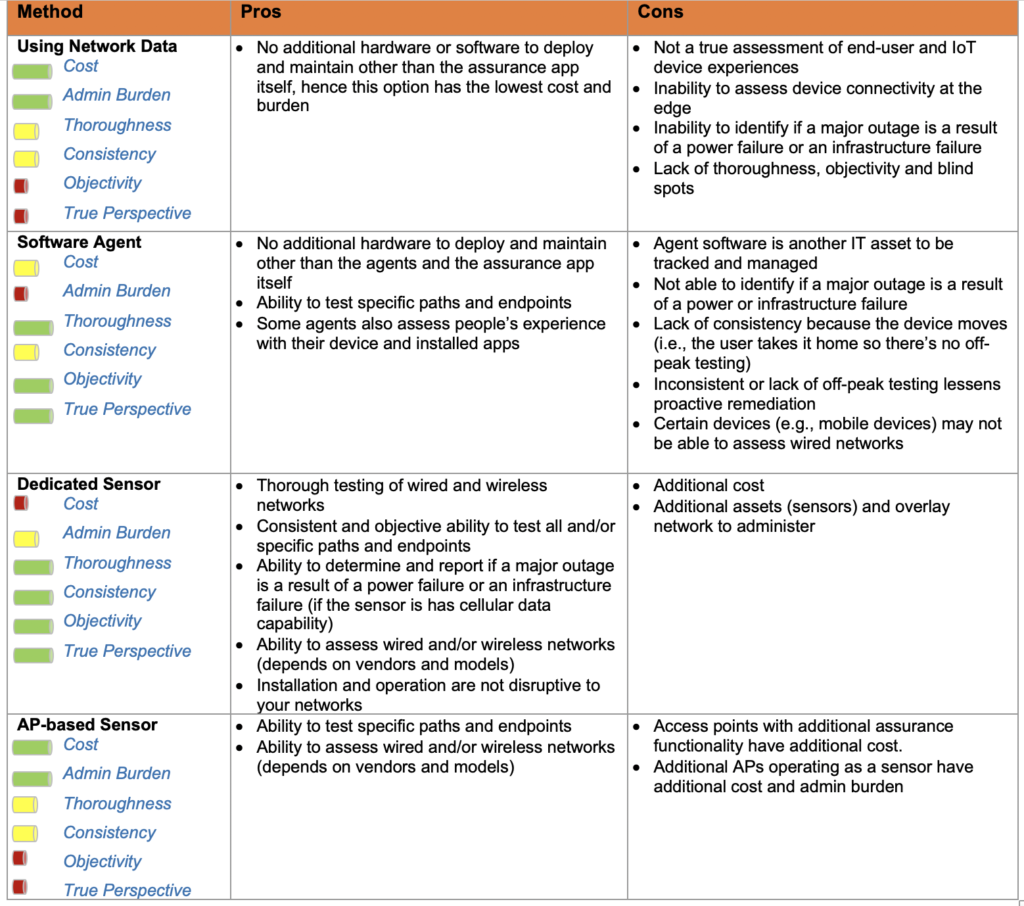TLDR: An outside-in and network-independent approach is the most thorough and objective way to assess and assure network performance – let’s call this experience monitoring. Obtaining performance information from client devices is the only way to truly know what they experience. Let’s call this combination experience assurance because the outcome is consistent satisfactory connectivity experiences for end-user and IoT devices.
 A key takeaway from my previous blog, What is Assurance? Why do I need it? Why does it need to be independent from my network? is that an outside-in and network-independent approach is the most thorough and objective way to assess and assure network performance – let’s call this experience monitoring. Obtaining performance information from client devices is the only way to truly know what they experience. This perspective is different yet complementary to the traditional approach of using information from a network monitor to manage a network and assure its performance.
A key takeaway from my previous blog, What is Assurance? Why do I need it? Why does it need to be independent from my network? is that an outside-in and network-independent approach is the most thorough and objective way to assess and assure network performance – let’s call this experience monitoring. Obtaining performance information from client devices is the only way to truly know what they experience. This perspective is different yet complementary to the traditional approach of using information from a network monitor to manage a network and assure its performance.
Methodology and Outcome
In my first blog, I asserted there are two aspects to assurance – a methodology and an outcome. Let’s call this combination experience assurance because the outcome is consistent satisfactory connectivity experiences for end-user and IoT devices. The methodology to achieve this objective requires using tools that provide visibility and insights that allow network operators to understand what’s happening and quickly initiate the best possible corrective action. An experience assurance solution should therefore provide:
- Experience Monitoring with experience-centric performance metrics
- Issue Detection, ideally including the root cause
Criteria for Assuring Connectivity Experiences
Thoroughness – All paths and connectivity stages must be assessed so you have complete experience visibility. Paths include specific networks (i.e., “main” and “guest”), VLANs and Wi-Fi SSIDs. Connectivity and throughput should be assessed from the point of connection to endpoints and apps. Ideally assessments should include the responsiveness of apps to minimize your troubleshooting and remediation efforts. Stages include all actions that establish secure and authenticated connections.
Consistency – Ideally any changes to assessment metrics should be because either something in the network or RF environment changed (the latter pertaining to Wi-Fi). Assessment testing should also be consistently executed on a recurring schedule that covers periods of low and high traffic that makes it possible to compare similar periods such as time of day, day of week, etc. The granularity and precision of test results should also be consistent.
Objectivity – Test results and metrics must be captured and scored independent from a network’s own assessment of its performance. This is the only way to have an unbiased understanding of performance.
True End-Use Understanding – Because RF is impacted by distance and environmental factors, Wi-Fi should be assessed at the same locations and in the same ways as end-user and IoT devices. Doing so gives you the most accurate understanding performance and issues.
Common Methods of Obtaining an Experience Perspective of Performance
- Analyzing network activity log and telemetry data from normal end-user and IoT traffic.
- Using software agents that run on client devices to assess performance. Agents are deployed to run on various devices such as PCs, tablets and smartphones.
- Using dedicated hardware sensors, which is the method used by the Aruba User Experience Insight solution.
- Using an access point (AP) to assess performance in one of two ways. One way is to run software in the sensor that causes it to act as a sensor, the other is using a separate radio for assessment.
Comparison of Network Experience Assurance Methods
The table below uses the criteria and methods in the preceding sections to compare the common methods for assessing and assuring experiences.

The criteria, methods and comparison information in this blog should help you understand the different methods, products and corresponding pros and cons of each method. If assuring the best possible connectivity experiences is essential, the information in this blog highlights why Aruba User Experience Insight is the best option.
Related Content
Blog: What is Assurance? Why do I need it? Why does it need to be independent from my network?




